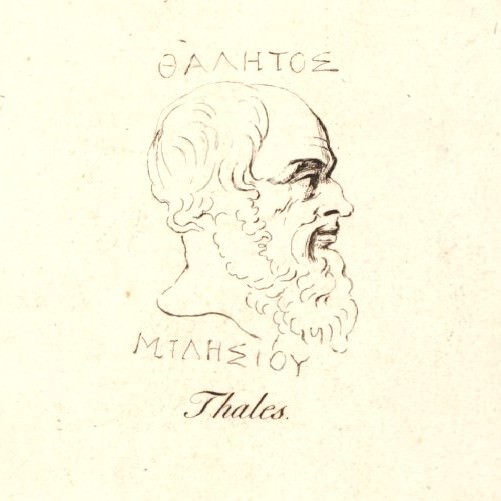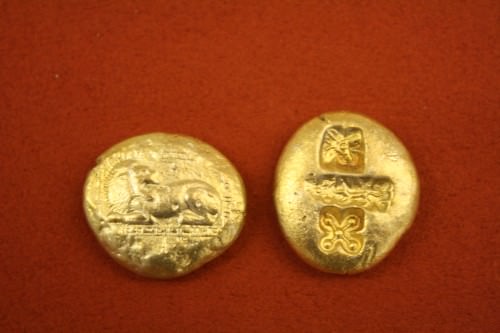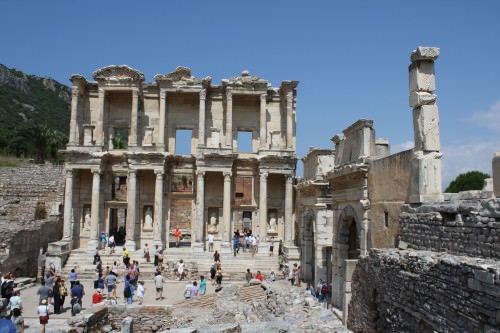
Definition
Ionia is the name given during ancient times to the central region of Anatolia’s Aegean shore in Asia Minor, present-day Turkey, one of the most important centres of the Greek world. Here the Greeks founded a dozen mini-states, two of them on the offshore islands of Chios and Samos, the rest of them stretching along the strip of mountainous coastland. During the 6th century BCE, Ionia became the focus of the intellectual life of Greece, a period known as the “Ionian awakening”, a name for the initial phase of classical Greek civilization.
Using the sea as a highway, which was much cheaper, faster, and more efficient than transport by land, the Greeks expanded and developed in a such a way that conflict with a major power became inevitable. The Greco-Italian-Sicilian trading route that the Greeks controlled competed more and more with the Oriental Indo-Persian-Phoenician and this commercial rivalry set the stage for war. Ionia was the initial setting of the Greco-Persian wars.
Origin of Ionia
Ionia was colonized by Greeks from the Athens region around 1000 BCE. The commercial activity in Ionia was in competition with the Phoenicians, who were the leaders of sea-trade at that time. However, some important changes took place on the eastern shore of the Mediterranean during the 8th century BCE: Assyria renewed their strength like never before, and the Phoenician city-states were conquered. The Phoenician sea-trade withered, and the Greek city-states took advantage of the Phoenician subjection to Assyria and gradually turned into the leading sea-traders and navigators. Some Phoenician colonies in the west remained independent, and the only serious competition the Greeks came across was from the expanding power of Carthage.
Ionian intellectuals were not heavily influenced by religion nor limited by ancient books claiming truth or divine revelation.
During the following centuries, Ionian cities underwent important changes. Political and economic power, which used to be concentrated in the hands of the landowning aristocracy, gradually moved to the merchant class. Ionian merchants established colonies as trading posts in Egypt, Italy, and along the Black Sea. Miletus alone, the southernmost Ionian city, had about 80 colonies and became the richest city in the Greek world. The wealth and luxury of the city was proverbial throughout Greece. Milesian merchants had such levels of profits that they lent money to a number of enterprises and even to the municipality itself.
IONIAN Intellectual Life
To the east of the Ionian city-states lay the Kingdom of Lydia. Ionians and Lydians remained on peaceful terms, with very tight cultural and commercial relations. The city of Sardis, Lydia’s capital, was an important centre for the traffic of goods and ideas between Mesopotamia and the Greek Ionian settlements. Beliefs, customs, and knowledge, in addition to commercial goods, were constantly circulating in Sardis.
By the time when Ionian cities became the intellectual leaders of Greece in the 6th century BCE, the city of Miletus became the focus of an intellectual revolution. In this city the power was in the hands of merchants and the priesthood had no significant social impact. Ionian intellectuals were not heavily influenced by religion nor limited by ancient books claiming truth or divine revelation. Even Homeric poems had hardly taken any definite form yet. Milesians were used to travelling to distant regions and received the input of the civilizations of Lydia, Babylon, Phoenicia, and Egypt. Mathematical knowledge, foreign commerce and geography, astronomy, navigational techniques, all these notions helped to enrich Miletus. Meanwhile, wealth had created leisure, and freedom of thought was widely accepted. All these factors can help to understand how a number of Ionian minds developed the idea that the world could be understood in terms of physical phenomena, without reference to myths or superstitions. The revolutionary idea of replacing supernatural explanations with the concept of a universe that is governed by laws of nature began in Miletus, with a man named Thales.
Thales of Miletus is credited as the author of a revolutionary hypothesis concerning the fundamental structure of the universe by claiming that water was the original substance of the universe. He is famous for his astronomical knowledge that allowed him to predict a total eclipse of the sun and also for his knowledge on geometry, which he brought from his visit in Egypt. This new rational insight influenced other Ionians thinkers such as Anaximander and Anaximenes, who also continued this rationalistic tradition. In many cases their ideas led to conclusions surprisingly similar to what our more sophisticated methods have led us to believe today. In Ionia we find the roots of the Western scientific tradition.
Miletos Electrum Stater
Persian Control & Revolt
The political map of this region started to change around 612 BCE. The Assyrian Empire came to an end as a result of the destruction of Nineveh, its capital, the most powerful city in the world at that time. An allied army of Persians, Medes, Chaldeans, and Babylonians besieged and sacked the centre of Assyrian power. This left Babylon as the imperial centre of Mesopotamia and Lydia was now free to turn its attention to the West. The Ionian cities were now dominated by Lydia, but Lydian rulers admired the Greeks and treated the Ionian cities leniently. Croesus, the last Lydian king, even paid for the construction of the Temple of Artemis, which became one of the Seven Wonders of the Ancient World. Soon after, Persia became the dominant power of Mesopotamia, putting an end to the Babylonian supremacy. In 546 BCE, the Persian king Cyrus II defeated Croesus and Lydia, which along with the Ionian cities, became controlled by the Persians.
About 500 BCE, the Ionian cities under Persian control dismissed the Persian authorities and declared their independence, triggering the Ionian revolt, the first of the many military conflicts between Greeks and Persians. Miletus was the leading state and Athens sent a fleet of 20 ships to support the revolt. Each Ionian rebel state raised its own troops but kept them under separate command. The army of Miletus marched upon Sardis and burned it to the ground.
In 494 BCE, the Ionian cities organized a united fleet that engaged the Persian navy at Lade in one of the most important sea battles of history. Just before the battle began, about 50 ships belonging to the navy of the Ionian city of Samos sailed away due to a secret arrangement they had with the Persians. Many other contingents following their disloyal example. The Ionian defeat was complete and Ionian civilization never managed to fully recover from this disaster.
The Persians captured Miletus, all the males were killed, the women and children enslaved, and from that day the city became a minor town. Persian control was re-established throughout Ionia until the decisive Greek victory at the Battle of Salamis (480 BCE), when the Ionian cities regained their independence and helped to form the Delian League with Athens.
Celsus Library, Ephesos
Hellenistic Period, Seleucid Control, & Roman Control
Around 334 BCE, Alexander the Great marched down into Ionia, offering the Greek cities democratic self-governance under his protectorate. Most cities opened their gates without resistance and enjoyed a new era of prosperity during the Hellenistic period, but none of them restored their previous splendour. Miletus refused Alexander’s offer and was finally levelled after a long siege and was never restored to its previous status as a leading city. The region then became part of the Seleucid, and later of the Attalid, Kingdom.
About 130 BCE Ionia came under Roman control and became part of the Roman province of Asia. This new period allowed many of the Ionian cities to recover some of their lost success. The archaeological record in Miletus suggests that the population reached a new peak, which is hard to estimate, although some scholars suggest a figure of 7000 or 8000. Smyrna and Chios were also considered important cities. Major monuments were expensively refurbished in the city of Ephesus during the 4th century CE, including the stadium, the theatre and the harbour baths. Today, the site of Ephesus is considered a very valuable example of classical urbanism.




